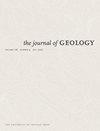Arc-Related Pyroxenites Derived from a Long-Lived Neoarchean Subduction System at the Southwestern Margin of the Cuddapah Basin: Geodynamic Implications for the Evolution of the Eastern Dharwar Craton, Southern India
IF 1.5
4区 地球科学
Q2 GEOLOGY
引用次数: 5
Abstract
Mineralogy and bulk-rock geochemistry (including Sr and Nd isotopes) of two ultramafic (pyroxenite) intrusions at Gurramkonda, situated adjacent to the southwestern margin of the Paleo-Mesoproterozoic Cuddapah Basin within the Eastern Dharwar Craton, southern India, are presented. The pyroxenites have a characteristic cumulate texture, with a predominance of pyroxene (augite) and amphibole (hornblende and actinolite), whereas chromite is present mostly as inclusions in pyroxene. Mineral chemistry of these ultramafics is akin to that of arc cumulate rocks, particularly those associated with the Alaskan-type complexes, formed in suprasubduction zones. High Mg#’s (72–74), coupled with high bulk-rock Ni (830–1130 ppm) and Cr (1110–1,360 ppm), strikingly correspond to those of continental arc cumulates. The enrichment of large ion lithophile elements over high field strength elements, conspicuous negative Nb-Ta, Zr-Hf, and Ti anomalies, and chondrite-normalized light rare earth element patterns highlight their arc affinity. Fluid-related modification of the mantle source is apparent from the various trace-element ratios. Negative ɛNd2.15Ga values (−0.93 to −2.90) also support contribution of an enriched-mantle reservoir in their genesis. Partial melting of this fertile mantle source has been attributed to the Paleoproterozic lithospheric extension with heat contributions from a mantle plume or convective asthenosphere. Ultramafic intrusions of arc-related geochemical affinity thus constitute rare, but genetically important, occurrences within the Eastern Dharwar Craton. We propose that, together with the recently studied calc-alkaline lamprophyres occurring immediately toward the western margin of the Cuddapah Basin, the Gurramkonda pyroxenites are manifestations of a long-lived and major subduction system of Neoarchean age in the Eastern Dharwar Craton, southern India.Cuddapah盆地西南边缘一个长期存在的新太古代俯冲系统的弧相关辉石:印度南部Dharwar火山口东部演化的地质动力学意义
介绍了印度南部达尔瓦尔克拉通东部古中元古代库达帕盆地西南边缘附近Gurramkonda两个超镁铁质(辉石岩)侵入体的矿物学和大块岩石地球化学(包括Sr和Nd同位素)。辉石岩具有典型的堆积结构,以辉石(辉石)和角闪石(角闪石和阳起石)为主,而铬铁矿主要以包裹体的形式存在于辉石中。这些超镁铁质岩的矿物化学性质类似于弧堆积岩,特别是那些与阿拉斯加型杂岩有关的岩石,形成于超俯冲带。高Mg#(72–74),再加上高体积岩石Ni(830–1130 ppm)和Cr(1110–1360 ppm),与大陆弧堆积体惊人地对应。大离子亲石元素对高场强元素的富集,明显的负Nb-Ta、Zr-Hf和Ti异常,以及球粒陨石归一化的轻稀土元素图案,突出了它们的电弧亲和力。从各种微量元素比例来看,地幔源的流体相关变化是显而易见的。负的Nd2.15Ga值(-0.93至-2.90)也支持富集地幔储层对其成因的贡献。这一肥沃地幔源的部分熔融归因于古变形岩石圈的伸展,热贡献来自地幔羽流或对流软流圈。因此,具有弧相关地球化学亲和力的超镁铁质侵入体在达尔瓦尔克拉通东部构成了罕见但在遗传学上重要的矿点。我们提出,加上最近研究的直接发生在库达帕盆地西缘的钙碱性煌斑岩,Gurramkonda辉石岩是印度南部达尔瓦尔克拉通东部新太古代长期主要俯冲系统的表现。
本文章由计算机程序翻译,如有差异,请以英文原文为准。
求助全文
约1分钟内获得全文
求助全文
来源期刊

Journal of Geology
地学-地质学
CiteScore
3.50
自引率
5.60%
发文量
0
审稿时长
3 months
期刊介绍:
One of the oldest journals in geology, The Journal of Geology has since 1893 promoted the systematic philosophical and fundamental study of geology.
The Journal publishes original research across a broad range of subfields in geology, including geophysics, geochemistry, sedimentology, geomorphology, petrology, plate tectonics, volcanology, structural geology, mineralogy, and planetary sciences. Many of its articles have wide appeal for geologists, present research of topical relevance, and offer new geological insights through the application of innovative approaches and methods.
 求助内容:
求助内容: 应助结果提醒方式:
应助结果提醒方式:


